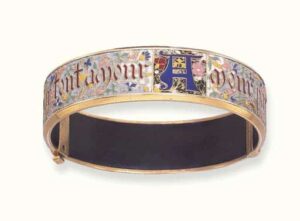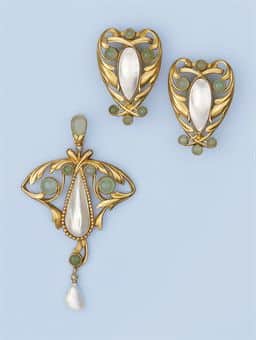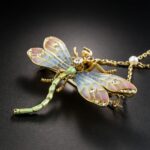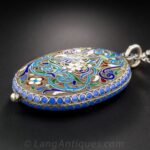
Photo Courtesy of Christies
Renowned French jewellery house famous for its cloisonné enameling and Japanese-inspired designs. The firm’s history begins in 1832 when Alexis Falize (1811-1898) began an apprenticeship with Parisian jeweller Mellerio dit Meller.1 An eager pupil, Falize quickly learned all aspects of the trade: manufacturing, chasing, engraving, design, sales, and bookkeeping. Looking to improve his marriage prospects, he left Mellerio in 1835 for Janisset. In 1838, he left Janisset to open up his workshop. “Such were the beginnings,” wrote Henri Vever, “of this highly talented jeweler, whose work as a designer and manufacturer was so significant.”2 Vever credited Falize with revitalizing jewellery and the decorative arts during Napolean III’s reign (1852-1870). His specialty was “artistic” jewellery: jewellery featuring semi-precious gemstones, intricate metalwork, and enamelling.
From 1860 to 1865, Falize experimented with enamels and studied with the most talented enamellists of the time. In 1871, he introduced a new method of cloisonné enameling. His work was widely copied and sparked a general interest in the use of brightly colored enamels. Inspiration for his designs was drawn from almost every historical era and many cultures, including those of Persia, India, and Japan.

Photo Courtesy of Christies.
When Falize retired in 1876, his son Lucien (1839-97) assumed control of the workshops. Having trained with his father for the previous two decades, Lucien was a competent successor—a highly skilled enamellist, goldsmith, and designer. His obsession with eras past (especially the Renaissance) and Japanese art matched, if not surpassed, that of his father. In 1878, Falize won a grand prize for his jewellery as well as a coveted Legion of Honor Cross at Paris’s International Exposition. In 1878, he joined forces with descendants of Bapst, the former French Crown Jewellers, to create jewellery for Paris’s wealthy aristocrats. Until 1892, Bapst et Falize enjoyed great prosperity. Around that time, Falize helped to theorize the burgeoning Art Nouveau movement, contributing articles to Samuel Bing’s monthly journal Le Japon Artistique.3Jewelers, led by Lucien Falize,” says Vivienne Becker, “seized on the simplicity of form, the intensity and clarity of colour of Japanese enamels, and the intriguing effect of mixed metal work…These were the very attributes of Art Nouveau jewels.”4
When Lucien suddenly died in 1897, his sons (André, Jean, and Pierre) continued the business as Falize Frères. They produced beautiful Art Nouveau pieces, winning two grand prizes at Paris’ International Exhibition in 1900.
Maker's Marks & Timeline
Falize Aine Fils
| Country | |
|---|---|
| City | Paris |
| Symbol | cartouche, frame, hexagon, lozenge |
| Shape | cartouche, frame, hexagon, lozenge |
| Era | e.1838 |
Specialties
- Alexis helped develop Cloisonné techniques for jewelry.
- Created Japanese motif enamel medallions, pendants, etc.
- Renaissance Revival Jewelry
- Lucien Worked in Basse-Taille, reviving the technique.
- André – Falize Frères – produced Art Nouveau jewelry.
1811
- Alexis Falize Born in Liège
1823
- Moves to Paris
Alexis Falize 1833-35
- Trained at Mellerio Frères
1835-1848
- Head of atelier and designer at Janisset
1838
- Takes over Aristide Joureau-Robin’s workshop.
1839
- Birth of Lucien Falize.
1840-1871
- 6 rue Montesquieu branch
1841
- Registers master mark.
- Never exhibits under his own name.
1848
- Begins to create designs for Boucheron and others.
1856
- Lucien joins the firm.
1862
- Lucien is influenced by the International Exhibition in London and the Japanese items on exhibit there.
- Developed a style of cloisonné which he exhibited at the Paris Exhibition.
1864
- Co-founder of the Chambre Syndicale de la Bijouterie-Joaillerie-Orfevèrie
1868
- Falize, Fontenay & Massin – Ecole professionelle du dessin for training goldsmiths.
- 1871
1871
- Opens at 53 Avenue de l’Opera
- Merges with son Lucien – Falize père et fils
1876
- Alexis Falize retires.
1878
- Legion d’Honneur and Grand Prix at the Exposition Universelle
c.1880-1892
- Partnership with Germain Bapst Forming Bapst & Falize.
1894
- Lucien’s son André joins the firm.
1896
- Salon des artistes Française – Gallé glass mounted by Falize
1897
- Lucien Falize dies.
-
- Lucien Falize’s Sons form Falize Frères with André at the helm.
1898
- Alexis Falize Dies.
1900
- Falize Frères win Grand Prix at the Exhibition
1904
- Serbian Crown Jewels
Related Reading
Sources
- Becker, Vivienne. Art Nouveau Jewelry. New York: E.P. Dutton, 1985.
- Purcell, Katherine. Falize: A Dynasty of Jewelers. New York: Thames and Hudson, 1999.
- Vever, Henri. French Jewelry of the Nineteenth Century. Translated by Katherine Purcell. London: Thames & Hudson, 2001 [1906-8].



